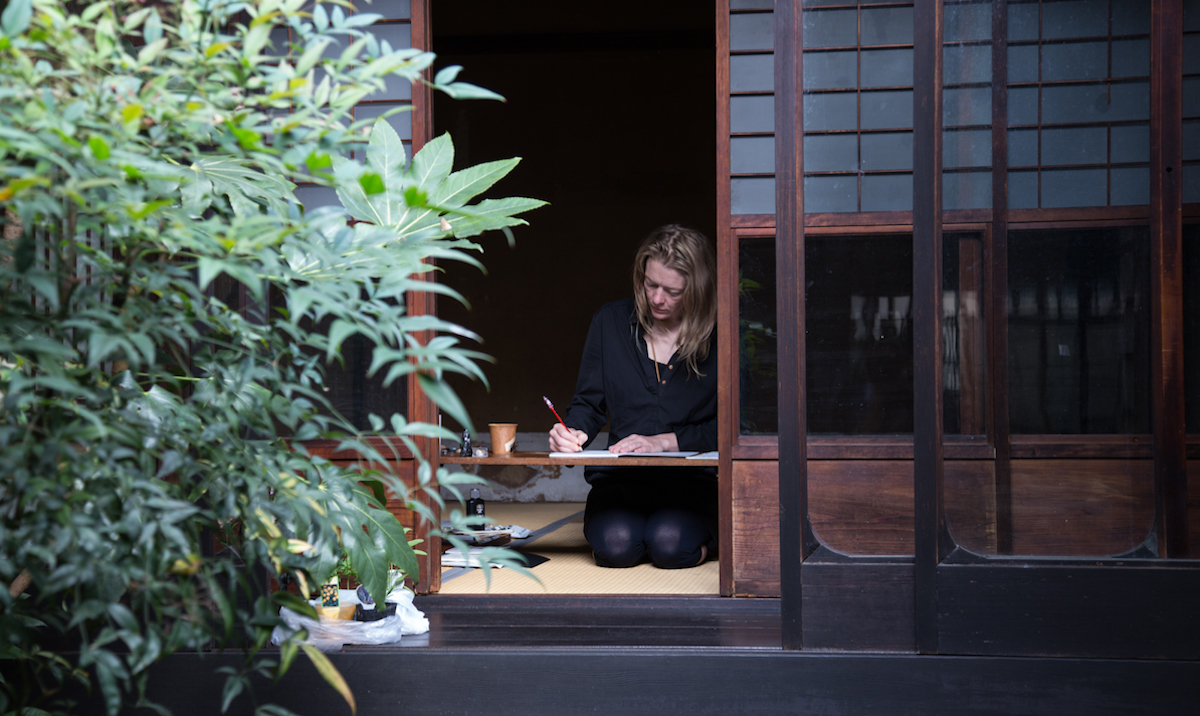レジデンス後のコメント 〜 Jikke Van Loonより
KYOTO MACHIYA AIR 2015(京町家AIR2015)の滞在アーティストJikke Van Loonより本レジデンスについてコメントが届いています。日本でのレジデンス期間を終えた彼女の生の声をどうぞご覧ください。
(なお、京町家AIR2015活動記録集には紙面の都合上、以下の本文より抜粋したものを掲載しています。)
アニュアル・ギャラリーでのアーティスト・イン・レジデンスは刺激的で、冒険的で、挑戦的で、美しかったです。町家に住んで、働くことで、私は日本の人の手段と考え方を知ることができました。日本社会での生活しかたと考えを説明する中で、町家は重要な役割がありました。町家は自分の家のように感じたと思います。町家にいて、ある程度祖父母の家を思い出しました。
庭に座って、毎朝手紙を書くことで、町家、京都での毎日の生活、京都で観た寺社やお店、出会った人、感じたフラストレーション、勉強になったことや旅行に反省しました。この手紙で日本でできた経験を共有して、日本とオランダの間のエアブリッジを確立しようと思いました。町家での出来事、町家で過ごした毎日や飯高さんとの町家の建築とデザインについての話は非常に勉強になりました。「隠された奥さんの扉」や日本社会の価値感や考え方が含まっている畳の寸法などについての話をしました。
私は町家で季節を感じることなどの「外」的な要素を本当に楽しみました。子どものころ、テントに泊まるような経験でした。寒くても、暑くても、いつもすっきりした気持ちでした。
特に町家で適切な仕事の仕方を見つけるのは難しかったです。私は彫刻家で、作業をすると空間を汚すので、適切の働き方を見つけるのは難しかったです。また解決方法を見つけずに、私は普段と違う材料を使おうとしました。今回粘土ではなく、書くことで作品の制作し方をしてみました。町家で普段と違う動き方や方ら来方が必要になったことは非常に興味深かったです。私は大きな動きや多くの体力が必要な作業になれていますが、そうした働き方を町家の建築に合わせなければなりませんでした。そして、町家でいつもの作業ができないので、私の精神を変える必要もありました。体で働くことができなくなったので、頭がとても早く働きました。目標に達成すること、ものを作ることしか先に進めないということを意識しました。成果展のために作品を制作するというアーティストとしての原則に向けることができなくなったことで、違和感を感じました。
日本でのはじめての滞在場所が京都、しかも京町家になってとても嬉しかったです。町家は伝統的な芸術、そして「間」や「侘び寂び」などの文化的要素を含まっていますから。私はこのような文化的要素、または日本の動き方、日本の集中し方、日本の道をより意識するようになりました。京都という町でもこのような文化的な要素が理解できました。京都の交通もオランダと全く違う動き方があるということを気付きました。京都にいることで、周りの人と一緒にオランダより穏やかで平和な動き方ができると思います。それに対して、オランダでは、できるだけ早くAからBまで行くことだけが重視されています。ここでは、もっと優しくて、調和的な動き方ができると思いました。ここでは、赤信号を無視するのはかっこよくないのに対して、オランダでは赤信号の前で待つのはとてもかっこよくなくて、時間に無駄だと思われています。ここで、青信号になる前に、リラックスして、本を読み終わるのを本当に楽しみました。
京都は魅力的で、美しい町です。様々な季節で京都に過ごすことで、私は町の様々な味を味わうことができ、日本の「時間の過ごし方」が認識できました。
Jikke Van Loon
My Artist in Residency at ANEWAL Gallery was an intense, adventurous, beautiful and challenging stay. Living and working in the machiya gave me an opportunity to get a feel of Japanese ways and ways of thinking. The machiya was the keyfigure in exploring the way of thinking and life in Japanese society. I felt very at home in the machiya. In a way it reminded me of my grandparents house. Sitting at the garden every early morning I wrote letters, scrutinuouly looking at my daily life in Kyoto, encounters with the machiya, temples, shops, people, frustrations, learning and trips, setting up and Airbridge between Japan and the Netherlands as to share my experiences. A lot a learning happened through my daily experiences in the machiya and my host and me discussing the why’s and how’s of the machiya architecture and design. ‘HIdden Wife Door’ and the sizes of the tatami where often departure for exploring Japanese society and thinking. I really enjoyed the ‘outdoor’ qualities of the machiya, living with and through the different seasons. Being too hot, too cold, but always fresh like sleeping in a tent I used to do when I was a child. For me it was difficult to find a ‘working’ mode in the machiya: as a sculptor being a ‘dirty’ artist it was difficult to find a way to work. For this I have not found a solution except for changing materials , from clay to writing. It was very interesting that the machiya asked me to act and move in a different way. Being used to big movements with lots of power and speed I had to adjust my ways in order to fit into the machiya architecture.
I also had to adjust my mental appoach in the machiya, since I could not do things the way I am used to. Since ‘working’ did not work, my mind was revolting. The only way I know doing things ‘right’ is ‘producing’ and achieving goals. It was very unsetling not to be able to cling on to these basic principles of being an artist: making things and yet having to perform and produce for the final exhibition.
I am happy as to have spent my first stay in Japan in Kyoto, and specially in a machiya since it still reflects old and ancient ways of art, encorporating qualities like MA, wabi sabi, attention etc. I developed more awareness of these aspects and also ‘the way’ of doing things , movements and concentration. Also the City of Kyoto taught me a lot on these aspects: the way the traffic moves is very different from the Dutch traffic. In Kyoto you felt so much more quiet and peace moving with each other. In Holland it is always about getting from A to B as fast as one can. Here it felt more like a gentle moving together in good harmony. Being in a hurry or crossing a red light is not considered ‘cool’, where as in Holland waiting for red light is a very uncool thing and a waste of time. I really enjoyed feeling relaxed in traffic and streets and finishing reading my book before continuing after red light turning green.
Kyoto is a facinating, beautiful city. Being in different seasons gave me the opportunity to experience it in different flavours and getting a feel for Japanese appreciation for ‘the passing of time’.
Jikke Van Loon
「京町家アーティスト・イン・レジデンス2015」
参加作家:ジッケ・ファン・ローン、イテケとチツケ・ヘムケス(計3名)
アーティスト滞在期間:9/25~12/16
成果発表展:12/4~6
レジデンス:ANEWAL Gallery、米田邸
共催:
日本カルチャーセンター・アムステルダム(‘t Japan Cultureel Centrum)
公益財団法人京都市景観・まちづくりセンター
特定非営利活動法人ANEWAL Gallery
後援:オランダ王国大使館、在大阪・神戸オランダ総領事館

